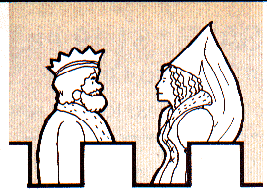
|
Lords and Ladys
by Stephen Reed
During the Middle Ages, life was short and simple. Seldom did anyone live past the age of 40, therefore earning a government post represented a very substantial accomplishment.
Of course, governments then were not what they are today. If you were not fighting your neighbors, you were probably busy fighting starvation or disease. Economies were based on little more than how much wheat was harvested each year.
Sounds simple???
Just remember, in those days, rulers were overthrown so fast that most of the subjects never knew who the local leader was!
Welcome to Lords & Ladys, where you have been given rule of a small territory. If you rule well and your state prospers, you will be promoted within the government.
Your goal is to become king of your assigned country.
This game supports from one to eight players and the first to become king of course wins. But life is short -- in this game -- and it's possible no one will live long enough to become king.
The game is straightforward and doesn't need instructions. I've purposely not told you the best ways to play because learning how to rule is the whole game in a nutshell.
Games of this nature have been around longer than home computers. The first Hammurabi or monarchy program was probably developed on a PDP system back in the 60s. But credit must be given here to two previous efforts from which this program is based. Ruler has been around since at least 1976 and its presentation inspired most economic programs to follow. Secondly, Santa Paravia was a significant contribution to economic simulation software. Originally developed on a Radio Shack Model 1, Santa Paravia was created about 1978.
Well, that's enough for you to go on. Take your time typing in this program -- and enjoy.
(Program code not yet available for download.)